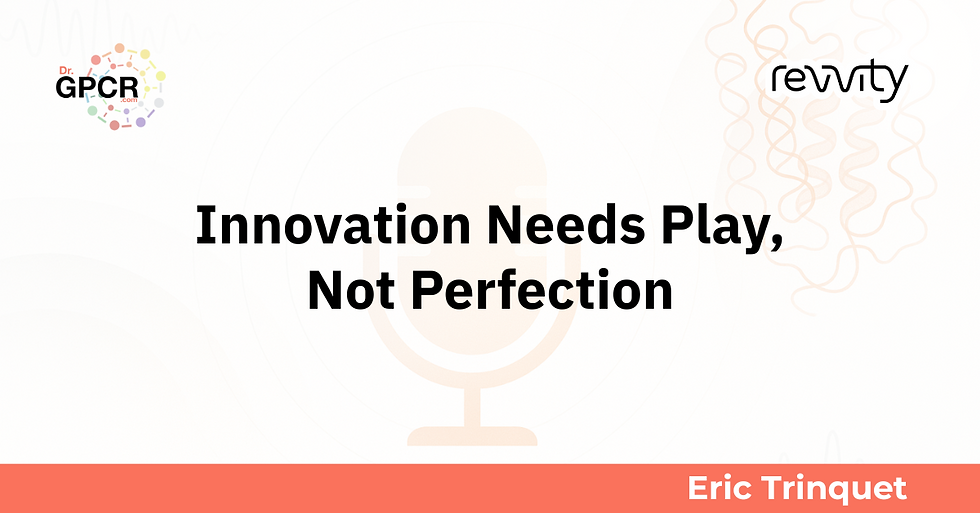From Pipettes to Platforms: The Evolution of GPCR Research
- Dr. GPCR Podcast

- 4 days ago
- 3 min read

The first time Michelle ran a cyclic AMP assay, she did it with a single-channel pipette, trays of melting ice, and the kind of focus that only comes from knowing one mistake could waste weeks of work.
We’d spend hours sitting there with trays of ice, transferring one by one with samples to a 384-well plate.
No robots. Just her, radioactive ligands, and steady hands.
That’s not a story about nostalgia — it’s a snapshot of how GPCR research was built, on technique at a time . And it’s a reminder that the way we do science today wasn’t inevitable — it was engineered, learned, and fought for by people who believed the field could be better.
The Era of Cold Fingers and Patience
Back then, GPCR signaling experiments weren’t elegant; they were endurance tests. Michelle describes spending hours in the lab measuring cyclic AMP levels — without multi-channel pipettes or high-throughput plate readers. Assay samples were layered on trays of ice.
These weren’t quaint inconveniences. They shaped how questions were asked.
These painstaking manual workflows laid the foundation for what would become the evolution of GPCR research — a transformation that reshaped how scientists design experiments and interpret signaling.
We were doing assays on ice, pipetting one sample at a time. Every step felt like it could make or break the result,
The pace and precision of GPCR research today — from high-throughput ligand screens to real-time signaling readouts — are built on the discipline forged in those early manual workflows.
When Technology Became a Force Multiplier
The introduction of multi-channel pipettes, automation, and standardized readouts wasn’t just an upgrade — it was a turning point. Suddenly, questions that were too risky or expensive to ask in the “manual era” became accessible. Instead of a dozen wells, you could test hundreds.
Michelle notes that the real shift wasn’t just speed. It was confidence. When technology reduced the cost of failure, scientists could push boundaries faster.
Reading those first papers on GPCR signaling organization absolutely fascinated me — the idea that receptors could cluster and control specificity blew my mind.
What Changed After This :
High-throughput capabilities meant researchers could map GPCR signaling more comprehensively. The field moved from single readouts to integrated signaling landscapes, accelerating drug discovery timelines and expanding targetable receptor families.
This leap mirrors what’s happening now in other parts of the field: platforms replacing isolated tools, enabling both reproducibility and creativity. Those early cyclic AMP assays weren’t just cold and slow — they were part of a bigger puzzle.
The Mindset Shift: From Technique to Strategy
Michelle reflects on how early-career researchers once prided themselves on “perfect hands.” Today, success depends less on manual precision and more on experimental design, data interpretation, and strategic collaboration.
In other words: the craft moved up the value chain.
Where once a well-run assay was the pinnacle, now it’s the foundation — a starting point for more ambitious questions about GPCR networks, biased signaling, and functional selectivity.
For Early-Career Scientists:
Don’t over-invest in proving your pipetting skills. The real leverage comes from mastering the strategy behind the experiment, not just the execution.
As technology absorbs the “how,” human expertise shifts to the “why” and “what if.” The GPCR field needs thinkers who can direct platforms, not just operate them.
Leadership, Luck, and the Lab
The episode isn’t just about technology — it’s also about how careers are shaped in science. Michelle’s path wasn’t linear. Like many, it was a mix of opportunity, timing, and the courage to say yes before everything was figured out.
Her career didn’t follow a straight line — it zigzagged through long nights, and calculated leaps. Technical mastery opened doors, but what kept her moving was knowing when to say yes before everything was figured out — and how to grow from great pipettor to PI.
Mini Timeline:
Manual assay years — technical rigor as foundation
Technology boom — scaling curiosity
Strategic shift — experiments as decisions
Leadership leap — from pipette to PI
The Evolution of GPCR Research
Every generation of GPCR scientists inherits the tools of the last and builds the next. What started as hand-built assays on ice has become integrated platforms for drug discovery, systems pharmacology, and real-time signaling analysis.
But the heart of the field hasn’t changed. It’s still driven by scientists asking hard questions — and refusing to accept slow answers.
Technology accelerates science, but people direct it. And those who understand both the legacy and the future of GPCR work are the ones shaping the next era of breakthroughs.
This isn’t just a history lesson. It’s a call to see your lab bench not as a constraint, but as a launchpad.
🎧 Listen to the full conversation with Michelle Halls on the Dr. GPCR Podcast
🔓 Get tools, deep dives, and exclusive insights with Dr. GPCR Premium.





Comments